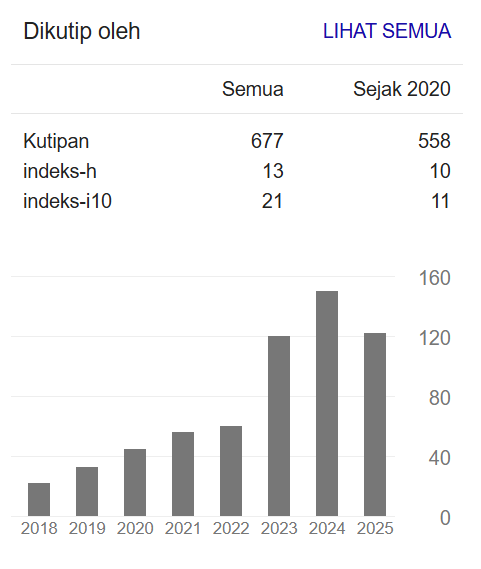EXISTENTIAL-PHILOSOPHICAL SYMBOLS AND MEANINGS IN THE SUFISTIC ROMAN “GHURBAH AL-GHARBIYAH” SUHRAWARDĪ
A HERMENEUTICAL STUDY
DOI:
https://doi.org/10.20871/kpjipm.v9i2.282Keywords:
Alienation, Philosophy of Illumination, Sufistic Imagination, Sufistic Liberation, Symbolic HermeneuticsAbstract
Suhrawardī, as the founder of illumination philosophy, has works in the field of literature that have philosophical nuances. Researchers through this article attempt to examine philosophically-hermeneutically the Sufistic Romance of Ghurbah al-Gharbiyah Suhrawardī which has not been extensively studied by researchers including Suhrawardī scholars. The novel is genealogically related to Ḥay bin Yaqẓān by Ibn Sīnā and Ibn Ṭufayl, so it is called the Ḥay bin Yaqẓān trilogy: Avicenna, Ibnu Ṭufayl, and Suhrawardī. Through Ricoeur’s Hermeneutic Approach and Corbin’s Epistemology of Sufistic Imagination, which is used as a research method, researchers intend to interpret the symbols and existential meanings of Ghurbah al-Gharbiyah's novel. The purpose of this study is to interpret the background, symbols, and meaning behind Suhrawardī’s novel. The conclusion of this study: Ghurbah al-Gharbiyah discusses the philosophical theme of human alienation in the world with the use of symbols: the city of Qairawan as the imprisoned phase, the Hudhud bird as the enlightenment phase, and the journey on Mount Sinai during the liberation phase and meeting with the "Light of all Lights". Three phases each characterize today's Sufistic consciousness of man: the experience of alienation, enlightenment, and liberation. On the other hand, this novel is a representation of Suhrawardī's subjective creative imagination (al-quwwah al-khayāliyyah) inspired by prophetic experiences: Prophet Muhammad's Ascension, Prophet Sulaiman's Hudhud bird, and Prophet Musa's Mount Sinai.
Downloads
References
Abidin, Aslan. 2016. “Sense, Reference, dan Genre Novel Merahnya Merah Karya Iwan Simatupang (Analisis Hermeneutika Paul Ricoeur).” RETORIKA: Jurnal Bahasa, Sastra, dan Pengajarannya 9 (1): 10–18. https://doi.org/10.26858/retorika.v9i1.3788.
Amīn, Aḥmad. 2008. Ḥay bin Yaqẓān li Ibn Sīna, Ibn Ṭufayl wa Suhrawardī. Kairo: Dār Ma‘ārif.
‘Atūm, ِAl-Layth Sālih. 2014. “Al-Falsafah al-Ishrāqiyah Inda al-Suhrawardī Min Khilal Qiṣṣatihi al-Ghurbah al-Gharbiyah.” Al-Majallah al-Ardaniyyah fi al-Dirāsāt al-Islāmiyyah 10 (3): 547–75.
Corbin, Henry. 1998. Tārikh al-Falsafah al-Islāmiyyah. Beirūt: Awīdat li Nashri wa Ṭabā‘ah.
———. 2002. Imajinasi Kreatif Sufisme Ibn ‘Arabi. Translated by Moh. Khozim and Suhadi. Yogyakarta: LKiS.
Fithri, Widia. 2014. “Kekhasan Heremeneutika Paul Ricoeur.” Majalah Ilmu Pengetahuan dan Pemikiran Keagamaan Tajdid 17 (2): 187–211. https://doi.org/10.15548/tajdid.v17i2.125.
Hanafi, Hasan. 2012. Dirāsāt Islāmiyyah. Kairo: Maktabah Anjelo al-Miṣriyah.
Hardiman, F. Budi. 2015. Seni Memahami Hermeneutika Dari Schleimacher sampai Derrida. Yogyakarta: PT Kanisius.
Ihsan, Nur Hadi, Martin Putra Perdana, and Yongki Sutoyo. 2022. “The Concept of Suhrawardi’s Hudhuri Epistemology and Its Relevance to the Contemporary Challenges.” Dialogia 20 (1): 84–108. https://doi.org/10.21154/dialogia.v20i1.3364.
Irbi‘, Sihām Aḥmad ‘Ammār al-. 2017. “Al-Ramziyyah fī Qiṣṣah Ḥay bin Yaqẓān li Ibn Sīnā.” Majallah al-Bahth al-‘Ilmi fi al-Adab 18 (1): 1–31. https://doi.org/10.21608/jssa.2017.10718.
Kamaliah, Alfi. 2021. “Imajinasi Kreatif dalam Pengalaman Mi’raj Ibn Arabi.” Living Islam: Journal of Islamic Discourses 4 (2): 197–214. https://doi.org/10.14421/lijid.v4i2.2793.
Kāẓim, Sālim Jum‘ah. 2021. “Ru’yah al-‘Ālam fī (Ḥay bin Yaqẓān) Dirāsāh fī al-Nuṣūṣ al-‘Arba‘ah li Ibni Sīnā wa Ibn Ṭufayl wa Sahruwardī wa Ibn Nafīs.” Majallah al-Jāmi‘ah al-‘Irāqiyah 50 (2): 179-194.
Makkī, Abī Muḥammad ‘Abdullah Ibn As‘ad Yāfi‘ī al-. 1997. Mirat al-Jinān wa ‘Ibrah al-Yaqẓān fī Ma‘rifat Mā Yu‘tabaru Min al-Ḥawādith al-Zamān. Beirūt: Dār al-Kutub al-‘Ilmiyah.
Ma’rufi, Anwar. 2021. “Illuminasi Suhrawardi Al-Maqtūl Sebagai Basis Ontologi Filsafat Etika.” An-Nawa: Jurnal Studi Islam 3 (2): 54–66. https://doi.org/10.37758/annawa.v3i2.343.
Maṭar, Ṣāliḥ ‘Aṭiyyah Ṣāliḥ. 2009. “Balāghah al-Sard fī Kutub al-Mi‘rāj Bayna al-Falsafah wa al-Taṣawūf: Dirāsāt Uslūbiyyah.” Majallah Buḥūth Kuliyyah al-Ādab Jāmi‘ah al-Manūfiyah 20 (76): 1–73. https://doi.org/10.21608/sjam.2009.138087.
Nasr, Sayyid Hossein. 1997. Three Muslim Sages. New York: Caravan Books.
Pamungkas, PG. 2016. “Distansiasi dan Apropriasi dalam Hermeneutika Sebuah Tinjauan Hermeneutika Paul Ricoeur.” Caritas pro Serviam 33: 67–77.
Rahman, Daden Robi. 2016. “Kritik Nalar Hermeneutika Paul Ricoeur.” Kalimah: Jurnal Studi Agama dan Pemikiran Islam 14 (1): 37–52. https://doi.org/10.21111/klm.v14i1.360.
Rajafi, Ahmad, and Ummi Hasanah. 2018. “Hadits Perempuan Melakukan Perjalanan Tanpa Maẖram Perspektif Hermeneutika Paul Ricoeur.” Aqlam: Journal of Islam and Plurality 3 (1). https://doi.org/10.30984/ajip.v3i1.633.
Rame, Gustaf R. 2014. “Hermeneutika Fenomenologis Paul Ricoeur.” Missio Ecclesiae 3 (1): 1–16. https://doi.org/10.52157/me.v3i1.33.
Rayyān, Muḥammad ‘Alī Abū. 1959. Uṣūl al-Falsafah al-Ishrāqiyah Inda Shihābuddīn al-Suhrawardī. Kairo: Maktabah Anjelo al-Misriyah.
Sastrapratedja, M. 2012. “Hermeneutika dan Etika Naratif Menurut Paul Ricoeur.” Kanz Philosophia: A Journal for Islamic Philosophy and Mysticism 2 (2): 247–64.
Shīrāzī, Qadbuddin al-. 1960. Sharh Ḥikmah al-Ishrāq li Sahruwardī. Teheran: Mu’assasah Muṭāla‘ah Islāmī.
Suhrawardī, Shiḥābuddin. 2018. Mawsu‘ah Muṣannafāt al-Sahruwardī. Beirūt: Dār Rawāfid.
Sumadi, Eko. 2015. “Teori Pengetahuan Isyraqiyyah (Iluminasi) Syihabudin Suhrawardi.” Fikrah 3 (2): 227–304. https://doi.org/10.21043/fikrah.v3i2.1798.
Walbridge, John. 2018. Illumination Texts and Textual Studies: Essays In Memory of Hossein Ziai. Boston: Brill.
Walidah, Ziana. 2022. “Cinta dalam Puisi Sufistik ‘Qasidah Al-Khamriyyah’ Karya Syaikh Abdul Qadir Al Jailani (Analisis Hermeneutika Paul Ricoeur).” Thesis, UIN Sunan Kalijaga Yogyakarta. https://digilib.uin-suka.ac.id/id/eprint/52804/.
Ziai, Hossein. 1996. History of Islamic Philosophy. London: Rouletge.
Downloads
Published
How to Cite
Issue
Section
License
Copyright (c) 2023 Lukman Hakim Rohim

This work is licensed under a Creative Commons Attribution 4.0 International License.





























